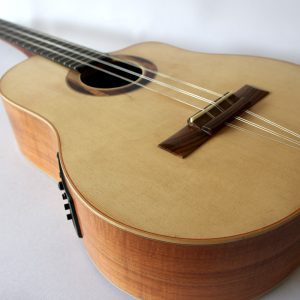Description
Membranophone, Percussed
Timbale
Senegal, Nigeria, Guinea, Togo, Liberia, Sierra Leone, Benin, Ivory Coast, Mali, Burkina Faso, Nigeria, Niger, Africa
Maintenance
The instrument includes basic maintenance (includes tuning and tuning of our instruments).
Warranty
LIFETIME WARRANTY. The warranty extends only to defects in materials or workmanship, does not apply to any defect caused by misuse, deterioration due to humidity, extreme temperatures, accidents or manipulation by third parties.
History of the Djembe
Djembe is one of the best known African instruments outside Africa. It is cup-shaped with a single membrane of goatskin, strained with interlocking ropes around the cup. The base of the drum can be cylindrical (djembe sulé) or conical (djembe bara) and usually have metal resonators such as large ears with many washers attached to the upper edge. The musician sometimes hangs it from his shoulders and touches it directly with his hands. When several djembes act at the same time, they resort to the very characteristic formula of dialogue, calls and responses between instruments.

It is believed that it originated in the year 900 BC in the tribe of the Maninka, which means people of Mande, although there are those who date that origin in 1300 BC. Mande would now be located approximately in Mali, not in vain Mali is a deformation of the word Mande and Malinke (the latter synonymous with Maninka). From here the djembé emigrated to other areas such as Senegal, Nigeria, Guinea, Ivory Coast and Burkina Faso.
It is believed to have been created by the Numu, wood-carving craftsmen, who were considered the guardians of certain powers. They were responsible for sculpting the body of the djembes and touching them.
The djembé is known in these places as the healing drum for its great power, it was used in sacred rites, births, weddings and funerals, accompanied by other instruments such as dundun, balafon or shekere. It has different rhythms, very rich and varied, we can name a few as:
- Mandiany, it was played in agricultural work
- Dounumba, it's played at weddings
- Wolosodon, this is played in baptisms and in the circumcision ceremony.
The original rhythms of djembé have changed over time, adapting to modern times and integrating with other types of music. The way in which rhythms such as SUNU or DOUNDUMBA have been passed down from generation to generation for centuries, has been through the complex syllabic and vocal system of African languages. The teachers sang the rhythms to their students and they practiced them.
The first expansion occurred in the 18th century by the Diola tribe who were merchants. But it was in 1950 that the djembé became known all over the world thanks to Les Ballets Africains' tour of Guinean Fobeda Keita. This group had a considerable impact and made the djembé known beyond its traditional borders. Migrations to Europe and the United States have also helped to popularize this instrument.
Source: Instrumundo
REFERENCE VIDEO
About the luthier, Mark Martin, Bubakar
"In the craft of luthier I found a channel of expression of my person, where I unload my essence and give me a lot of peace, sister to nature and feed my soul."
Multi-awarded and recognized Luthier, former vice president of the Association of Luthiers of Argentina, a reference in the creation of African instruments, supplier of instruments of renowned musicians, trained as a musician and craftsman in Africa.














Reviews
There are no reviews yet.